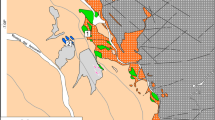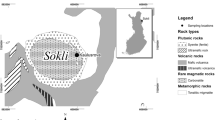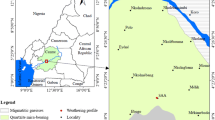Abstract
Chemical changes during the natural alteration of micas were studied by electron microprobe and classical chemical analyses of fresh and altered portions of mica flakes from 10 Canadian mineral deposits. Results of 50 new analyses are discussed in five examples, starting from simple changes in the interlayer followed by exsolution of titania and ending with complex replacements of anions and cations in all layers of the mica structure. Alteration of micas starts along 001 cleavage planes and fractures and gradually extends into the entire flake leaving some or no remnants of the host mica. The removal of ions from the mica structure and from the flake takes place by gradual depletion, by exsolution of oxides, and/or by alternating removal and redeposition of a newly-formed oxide, illustrated in the following example of the removal of Ti;
-
(1) removal of Ti from the mica structure and exsolution of rutile in the parent mica
-
(2) destruction of rutile and recrystallization as anatase on the surface of the mica; and
-
(3) destruction of anatase, removal of Ti from the surface of the host and crystallization of anatase away from the parent mica.
Residual minerals replacing the original micas are secondary and recrystallized micas, chlorite, vermiculite, serpentine, talc and depleted, optically amorphous flakes. Newly-formed minerals which may incorporate the released ions into their structures are rutile, anatase, sericite, hydronepheline, chlorite-serpentine aggregates, goethite and jarosite. The following partly-altered micas are indicative of sulphide mineralization;
-
(a) bright-green, partly altered phlogopite from ultrabasic rocks and from Co-Cu-Fe-Ni sulphide assemblages. The green phlogopite formed by replacement of K, Al and Ti by Fe, Mg and OH
-
(b) depleted mica coated with jarosite and Ni-goethite in the oxidation zone of a nickel deposit.
The jarosite formed from released S and Fe from decomposed Fe-Ni sulphides and K released from the host mica; and
-
(c) chlorite-sericite-biotite alteration zones adjacent to Pb-Zn-Cu-Fe deposits.
Similar content being viewed by others
References
Buchan, R. and Blowes, J. H. (1968) Geology and mineralogy of a millerite nickel ore deposit, Marbridge No. 2 mine, Malartic, Quebec: Can. Min. Met. Bull. 1–6.
Carlson, H. D. (1958) Geology of the Werner Lake-Rex Lake area: Ontario Department Mines Report 66, pt. 4.
Dawson, K. R. (1966) A comprehensive study of the Preis-sac-Lacorne batholith, Abitiby county, Quebec: Geol. Surv. Can. Bull. 142.
Hoda, S. N. and Hood, W. C. (1972) Laboratory alteration of trioctahedral micas: Clays and Clay Minerals 20, 243–258.
Farmer, V. C., Russell, J. D., McHardy, W. J., Newman, A. C. D., Ahlrichs, J. L. and Rimsaite, J. Y. H. (1971) Evidence for loss of protons and octahedral iron from oxidized biotites and vermiculites: Mineral. Mag. 38, 121–137.
Lachance, G. R. and Plant, A. G. (1973) Quantitative electron microprobe analysis using an energy dispersive spectrometer: Geol. Surv. Can. Paper 73-1, part B, 8–9.
Maxwell, J. A. (1968) Rock and Mineral Analysis. Interscience-Wiley, New York.
Mehmel, M. (1938) Ab- und Umbau am Biotit: Chem. d. Erde 11, 307–332.
Rimsaite, J. (1967a) Biotite intermediate between diocta-hedral and trioctahedral micas: Clays and Clay Minerals 15, 375–393.
Rimsaite, J. (1967b) Studies of rock-forming micas: Geol. Surv. Can. Bull. 149.
Rimsaite, J. (1970) Structural formulae of oxidized and hydroxyl-deficient micas and decomposition of the hy-droxyl group: Contr. Miner. Petrol. 25, 225–240.
Rimsaite, J. (1973a) Mica group minerals and related silicates in Canadian mineral deposits: Geol. Surv. Can. Paper 73-1. part B, 205–209.
Rimsaite, J. (1973b) Genesis of chlorite, vermiculite, serpentine and secondary oxides in ultrabasic rocks: Proc. Int. Clay Conf. 1972, Madrid, Spain, 291–302.
Robert, M. and Pedro, G. (1973) Etablissement d’un schema de l’evolution experimentale des micas trioctaed-riques en fonction des conditions du milieu (pH concentration): Proc. Int. Clay Conf. 1972, Madrid, Spain, 433–447.
Zurbrigg, H. F. (1963) Thompson mine geology: Can. Inst. Mining Met. Bull. 56, 451–460.
Author information
Authors and Affiliations
Rights and permissions
About this article
Cite this article
Rimsaite, J. Natural Alteration of Mica and Reactions between Released Ions in Mineral Deposits. Clays Clay Miner. 23, 247–255 (1975). https://doi.org/10.1346/CCMN.1975.0230312
Received:
Published:
Issue Date:
DOI: https://doi.org/10.1346/CCMN.1975.0230312




